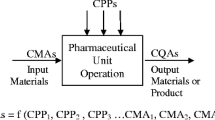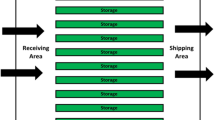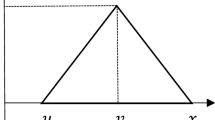Abstract
Quality of medical and pharmaceutical products has a key role in healthcare systems such as hospitals for better services to patients. This study proposes a comprehensive multi-objective mathematical model in healthcare supply chain considering quality and green concepts. The proposed model includes three objective functions. The first minimizes total manufacturing costs including transportation; purchasing maintenance, deterioration, setup, recycling, collecting and disposal costs. The second maximizes quality level of production. The third minimizes environmental effects of the products and transportations. The proposed model is complicated because of its nature and listed in the NP-hard. Hence, we use NSGAII approach for solving this model. The numerical example illustrates steps of the solution method. The solution representation for 4 suppliers, 2 recycling centers and 3 productions shows for supplier 1 (1100, 600, 1000) and supplier 2 (1000, 900, 400), recycling center 2 has a good performance and for supplier 3 (700, 500, 800) and supplier 4 (400, 950, 0), recycling center 1 has a good performance. Then, we need to improve the performance of the rest recycling centers per supplier. To measure the capabilities of multi-objective meta-heuristics, we used Number of Pareto solutions, spacing metric and quality metric criteria. Finally, the results show that the proposed algorithm has high quality to solve the model.











Similar content being viewed by others
References
Abdelkafi C, Beck BH, David B, Druck C, Horoho M (2009) Balancing risk and costs to optimize the clinical supply chain—a step beyond simulation. J Pharm Innova 4(3):96–106
Almarsdóttir, AB, Traulsen JM (2005) Rational use of medicines–an important issue in pharmaceutical policy. Pharm World Sci 27(2):76–80
Amaro A, Barbosa-Póvoa A (2008) Planning and scheduling of industrial supply chains with reverse flows: a real pharmaceutical case study. Comput Chem Eng 32(11):2606–2625
Aptel O, Pourjalali H (2001) Improving activities and decreasing costs of logistics in hospitals: a comparison of US and French hospitals. Int J Account 36(1):65–90
Azadeh A, Haghighi SM, Gaeini Z, Shabanpour N (2016) Optimization of healthcare supply chain in context of macro-ergonomics factors by a unique mathematical programming approach. Appl Ergon 55:46–55
Blau GE, Pekny JF, Varma VA, Bunch PR (2004) Managing a portfolio of interdependent new product candidates in the pharmaceutical industry. J Prod Innov Manag 21(4):227–245
Cetin E, Sarul LS (2009) A blood bank location model: a multi-objective approach. Euro J Pure Appl Math 2(1):112–124
Chen DQ, Preston DS, Xia W (2013) Enhancing hospital supply chain performance: a relational view and empirical test. J Oper Manag 31(6):391–408
Darling M, Wise S (2010) Not your father’s supply chain. Mater Manag Health Care 19:30–33
Dellaert N, Van De Poel E (1996) Global inventory control in an academic hospital. Int J Prod Econ 46:277–284
Féniès P, Gourgand M, Tchernev N (2004) Une contribution à la mesure de la performance dans la supply chain hospitalière: L’exemple du processus opératoire. Actes de GISEH 2004
Gatica G, Papageorgiou L, Shah N (2003) Capacity planning under uncertainty for the pharmaceutical industry. Chem Eng Res Des 81(6):665–678
George ED, Farid SS (2008) Strategic biopharmaceutical portfolio development: an analysis of constraint-induced implications. Biotech Progr 24(3):698–713
Griffin JA (2012) Improving health care delivery through multi-objective resource allocation. Unpublished doctoral dissertation, Georgia Institute of Technology
Haszlinna MN, Potter A (2009) Healthcare supply chain management in Malaysia: a case study. Supp Chain Manag Int J 14(3):234–243
Jabbarzadeh A, Fahimnia B, Seuring S (2014) Dynamic supply chain network design Fr the supply of blood in disasters: a robust model with real world application. Trans Res Part E: Log Trans Rev 70:225–244
Jayaraman V, Pirkul H (2001) Planning and coordination of production and distribution facilities for multiple commodities. Euro J Oper Res 133:394–408
Kelle P, Woosley J, Schneider H (2012) Pharmaceutical supply chain specifics and inventory solutions for a hospital case. Oper Res Health Care 1(2):54–63
Kim D (2005) An integrated supply chain management system: a case study in healthcare sector. In: Bauknecht K et al. (eds) E-commerce and web technologies. Springer, Berlin, pp 218–227
Kumar D (2014) Modelling rural healthcare supply chain in India using system dynamics. Proc Eng 97:2204–2212
Laínez JM, Schaefer E, Reklaitis GV (2012) Challenges and opportunities in enterprise-wide optimization in the pharmaceutical industry. Comput Chem Eng 47:19–28
Levis AA, Papageorgiou LG (2004) A hierarchical solution approach for multi-site capacity planning under uncertainty in the pharmaceutical industry. Comput Chem Eng 28(5):707–725
Marucheck A, Greis N, Mena C, Cai L (2011) Product safety and security in the global supply chain: issues, challenges and research opportunities. J Oper Manag 29:707–720
Masoumi AH, Yu M, Nagurney A (2012) A supply chain generalized network oligopoly model for pharmaceuticals under brand differentiation and perishability. Trans Res Part E: Log Trans Rev 48(4):762–780
Michelon P, Cruz MD, Gascon V (1994) Using the tabu search method for the distribution of supplies in a hospital. Ann Oper Res 50(1):427–435
Mousazadeh M, Torabi SA, Zahiri B (2015) A robust possibilistic programming approach for pharmaceutical supply chain network design. Comput Chem Eng 82:115–128
Nagurney A, Yu M, Qiang Q (Apr 2012) Multiproduct humanitarian healthcare supply chains: a network modeling and computational framework. In: Proceedings of the 23rd annual POMS conference, Chicago
Oh HC, Karimi IA (2004) Regulatory factors and capacity-expansion planning in global chemical supply chains. Ind Eng Chem Res 43(13):3364–3380
Papageorgiou LG, Rotstein GE, Shah N (2001) Strategic supply chain optimization for the pharmaceutical industries. Ind Eng Chem Res 40(1):275–286
Pitta DA, Laric MV (2004) Value chains in health care. J Consum Market 21(7):451–464
Rezaei M, Valipour M, Valipour M (2016) Modelling evapotranspiration to increase the accuracy of the estimations based on the climatic parameters. Water Conserv Sci Eng 1:197–207
Rotstein GE, Papageorgiou LG, Shah N, MurphyD C, Mustafa R (1999) A product portfolio approach in the pharmaceutical industry. Comput Chem Eng 23:S883–S886
Schott JR (1995) Fault tolerant design using single and multicriteria genetic algorithms optimization, Master’s thesis, Department of Aeronautics and Astronautics, Massachusetts Institute of Technology, Cambridge
Shah R, Goldstein SM, Unger BT, Henry TD (2008) Explaining anomalous high performance in a health care supply chain. Decis Sci 39(4):759–789
Sinha KK, Kohnke EJ (2009) Health care supply chain design: toward linking the development and delivery of care globally. Decis Sci 40(2):197–212
Sousa RT, Liu S, Papageorgiou LG, Shah N (2011) Global supply chain planning for pharmaceuticals. Chem Eng Res Des 89(11):2396–2409
Sundaramoorthy A, Xianming S, Karimi IA, Srinivasan R (2006) Presented in PSE-2006, July 09-13. An integrated model for planning in global chemical supply chains
Susarla N, Karimi IA (2012) Integrated supply chain planning for multinational pharmaceutical enterprises. Comput Chem Eng 42:168–177
Teng CW, Foley L, O’Neill P, Hicks C (2014) An analysis of supply chain strategies in the regenerative medicine industry—implications for future development. Int J Prod Econ 149:211–225
Tetteh E (2009) Creating reliable pharmaceutical distribution networks and supply chains in African countries: implications for access to medicines. Res Soc Adm Pharm 5(3):286–297
Timpe CH, Kallrath J (2000) Optimal planning in large multi-site production networks. Eur J Oper Res 126(2):422–435
Tsang KH, Samsatli NJ, Shah N (2007) Capacity investment planning for multiple vaccines under uncertainty: financial risk analysis. Food Bioprod Process 85(2):129–140
Turgay S, Taşkın H (2015) Fuzzy goal programming for health-care organization. Comput Ind Eng 86:14–21
Unger S, Landis A (2016) Assessing the environmental, human health, and economic impacts of reprocessed medical devices in a Phoenix hospital’s supply chain. J Clean Prod 112:1995–2003
Uthayakumar R, Priyan S (2013) Pharmaceutical supply chain and inventory management strategies: optimization for a pharmaceutical company and a hospital. Oper Res Health Care 2(3):52–64
Valipour M (2016) Variations of land use and irrigation for next decades under different scenarios. Irriga, Botucatu, Edição Especial, Irrigação, pp 262–288
Valipour M (2016b) How much meteorological information is necessary to achieve reliable accuracy for rainfall estimations? Agriculture 6:53. doi:10.3390/agriculture6040053
Valipour M, Banihabib ME, Behbahani SMR (2013) Comparison of the ARMA, ARIMA, and the autoregressive artificial neural network models in forecasting the monthly inflow of Dez dam reservoir. J Hydrol 476:433–441
Valipour M, Gholami Sefidkouhi MA, Raeini-Sarjaz M (2017) Selecting the best model to estimate potential evapotranspiration with respect to climate change and magnitudes of extreme events. Agric Water Manag 180:50–60
Yadav P, Lydon P, Oswald J, Dicko M, Zaffran M (2014) Integration of vaccine supply chains with other health commodity supply chains: a framework for decision making. Vaccine 32(50):6725–6732
You F, Grossmann IE, Wassick JM (2010) Multisite capacity, production, and distribution planning with reactor modifications: MILP model, bi-level decomposition algorithm versus Lagrangean decomposition scheme. Ind Eng Chem Res 50(9):4831–4849
Zavvar Sabegh MH, Mirzazadeh A, Maass E, Ozturkoglu Y, Mohammadi M, Moslemi S (2016) A mathematical model and optimization of total production cost and quality for a deteriorating production process. Cogent Math 3:1264175. doi:10.1080/23311835.2016.1264175
Zitzler E, Thiele L (1998) Multi objective optimization using evolutionary algorithms a comparative case study. In: Eiben AE, Back T, Schoenauer M, Schwefel HP (eds) 5th international conference on parallel problem solving from nature (PPSN-V), Berlin, pp 292–301
Zitzler E, Deb K, Thiele L (2000) Comparison of multi objective evolutionary algorithms: emprical results. Evol Comput J 8(2):125–148
Author information
Authors and Affiliations
Corresponding author
Rights and permissions
About this article
Cite this article
Moslemi, S., Zavvar Sabegh, M.H., Mirzazadeh, A. et al. A multi-objective model for multi-production and multi-echelon closed-loop pharmaceutical supply chain considering quality concepts: NSGAII approach. Int J Syst Assur Eng Manag 8 (Suppl 2), 1717–1733 (2017). https://doi.org/10.1007/s13198-017-0650-4
Received:
Revised:
Published:
Issue Date:
DOI: https://doi.org/10.1007/s13198-017-0650-4




